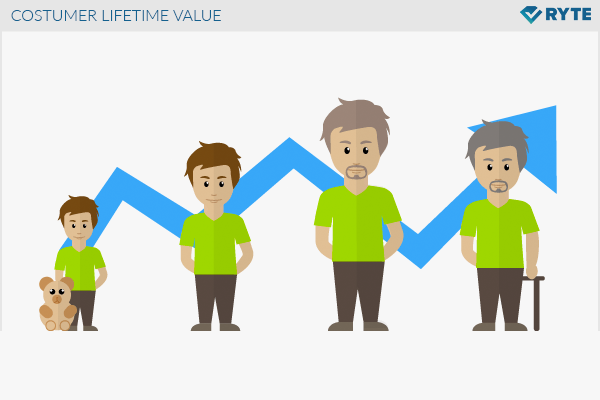Customer Lifetime Value
The customer lifetime value (CLV) is the value that a customer represents for a company over the entire period being a customer at that company. The CLV includes all the monetary transactions that have been made to date (customer profitability, CP) which the customer has given the company as well as any that will be potentially generated in the future.
Customer Lifetime Value is an important KPI and belongs to the area of business administration, in order to be able to plan marketing campaigns better and to optimize cost structures in customer management. For example, a high CLV can be accompanied by a high marketing budget so that the expected return on investment (ROI) is at a relatively high level. In addition, investments in Customer Relationship Management can be verified.
General information
The term customer lifetime value is often used to describe the transition from transaction marketing to customer relationship management. The value of an individual is focused on less, while the benefits of actions to maintain customer relationships are increasingly measured in the form of calculations coming from the areas of investment calculation and B2B Marketing. The CLV is based on the capital value method, which includes the interest on a value from the start of the investment.
Extension of the model for customer acquisition and relations
As an extended model, the CLV can also represent various phases of customer acquisition and maintenance in order to align marketing activities to specific customer requirements. For this purpose, the length of time of the person being a customer is divided into different customer cycles. For example, first customer contact, relationship setup, individualization, Cross-Selling or Retargeting. How the individual phases are designed depends on the objective of the survey. Various options exist, so that, for example, new customer acquisition, existing customer care or customer equity can be used as a modern performance indicator for the entire customer base. The latter aspect is the theoretical basis for the calculation of the CLV so that the overall importance of a customer for the company is considered an investment with an expected profit.
Customer lifetime value
T is the duration of the business relationship. eT are the revenue from a single customer. aT are the costs incurred for customer care. i is the calculation rate which uses the duration of the entire customer relationship as a calculation quantity. Average values are often used for the entire customer cycle. In other models, aspects such as sociodemographic factors (income, social background or other reference values) or the data provided by the customer as information values can be included in the calculation. The basic calculation of CLV:
CLV = Total T at the time T0 * (eT – aT/ (1 + i)*T)
Simplified example
Suppose the CLV of a customer of a mobile phone provider customer is to be calculated. The duration of the business relationship T is assumed to be 10 years. Correspondingly, the calculation rate is 10%, that is, 0.1 for use in the formula. Every two years the customer buys a new smartphone worth €400 (eT). The manufacturer applies €50 (aT) per year for customer care in the form of correspondence, telephone conversations, and emails. Since eT and aT are values that must relate to the period of the person being a customer, they are calculated in advance: 5 * 400 equals €2000 and 50 * 10 equals €500. Now the values are used in the CLV formula.
CLV= (2000 – 500 / (1 + 0,1)*10)
The client’s CLV is therefore €148.51 per year. Optionally, other aspects can be included here. If the customer has, for example, recruited another customer, this can be included in the calculation. Values such as the resale rate or cross-selling promotions can also be used. There are different models to calculate the customer lifetime value.[1]
Disadvantages
The CLV is based in part on estimated values and generally on sales which are associated with a certain degree of uncertainty. In particular, reference to possible sales poses a problem because they cannot be generally predicted. The potential sales can be considerably smaller than expected or even completely absent. The more a buying history exists, the more likely it is that the predictions will be met and that practically useful values will result when calculating the CLV. It is important how the underlying data is generated and collected. For example, Tracking in E-Commerce must map all transactions to a unique customer to achieve a viable database for the CLV. This affects the calculation aspects such as Data Protection or privacy. Therefore, the reference to the purchase history or other reference values must be anonymized.
Relevance to online marketing and relationship marketing
In e-commerce, the cost of customer relationship management can be kept relatively small as compared to over-the-counter retail. Especially email, social media and the Organic Search and related actions can map cost structures that result in a high CLV. According to a study from 2013, search engines seem to have a high CLV per se because users often use search engines to search for products, services, and brands. Thus, the CLV value is about 50% higher on average than in the paid search.
Email marketing is particularly interesting for young companies and start-ups, as high CLV values are expected in this area due to the low mailing cost. In general, startups using CLV should be able to keep track of the performance at the very beginning of the company in order to maximize monetization.[2] The ways and means to achieve a high CLV value are diverse. They range from personalized offers, improved customer service through sponsorships and loyalty programs, to lowering acquisition, logistics or other internal processes.
References
- ↑ Modeling Customer Lifetime Value anderson.ucla.edu. Accessed on 02/11/2015
- ↑ Startup Killer: the Cost of Customer Acquisition forentrepreneurs.com. Accessed on 02/11/2015

